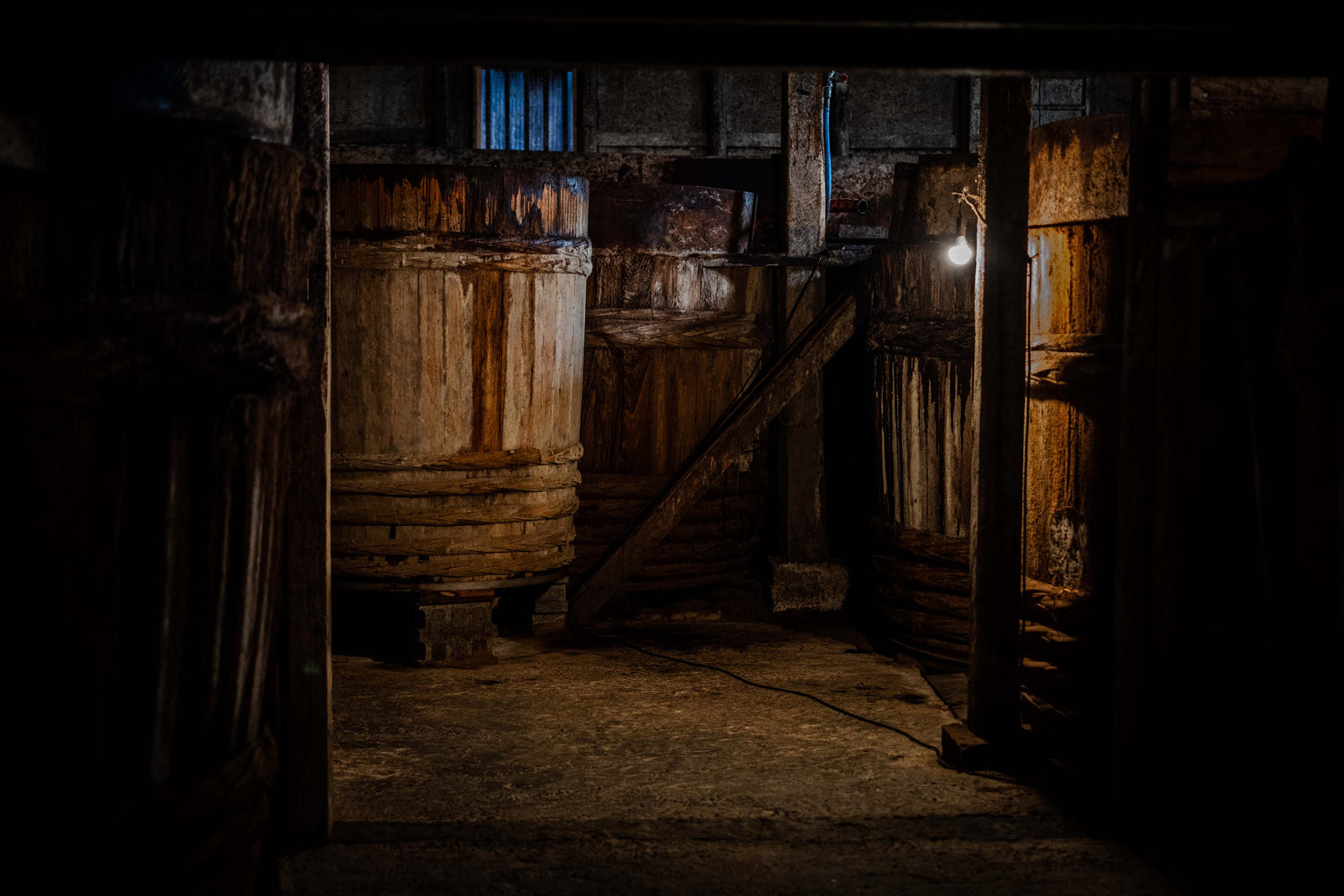Seemingly lost amid the remarkably blue waters of the Seto Inland Sea are the art islands. Here, hidden past the charming seaside towns and emerald hills thick with nature, one can encounter artistic works that range from the beautifully mystifying and borderline esoteric to the delightfully quirky, fun, and kitsch.
These islands include the famous ones known by many such as Naoshima with its iconic red and yellow pumpkins or Teshima and its stunning art museum. And it is true that these islands allow visitors entry to an entirely different universe where the lines between nature, art, and culture begin to blur and the mundanity of everyday life seems to vanish like mist in the sun. But this sensation becomes all the more tangible when discovering the smaller locales hiding in-between the popularity of more widely-known sanctuaries of artistic endeavor. And one example is the small yet entrancing island of Inujima.
Like many art islands, the walking trails of Inujima include “art house” projects hidden amid the almost unreal verdancy of the island’s nature which explodes into existence when nurtured by the heat of the summer sun and salty dampness hanging in the air. Among these open-air installations is contact lens by Haruka Kojin, an immediately eye-catching piece comprised of flowing glass and a mosaic of concave mirrors. When catching the sunlight, these mirrors twist and reflect the surrounding scenery, inverting the trees and homes captured inside these winking glass eyes and giving this new reflected reality an interesting “bubbling” effect as if somehow viewing the world from beneath the waters of a gigantic hot spring.
In addition to the art, the island is still inhabited even if just barely so. And it is not uncommon (at least for the time being) to catch the denizens, age-bent and wrinkled waving from their homes or gardens which are often choked with the overgrown sprawl of greenery that only a Japanese summer seems capable of producing while the air is thick with humidity and the buzzing of rotund, thumb sized bumblebees lazily hanging onto nearby plant life and art without distinction like absurd fuzzy, yellow fruits, only occasionally taking halfhearted flights to go about some rambling kind of business.
The fact that such a simple yet authentic scene of small-town life in Japan is somehow swept into the artistic landscape of Inujima certainly adds a certain charm and appeal in its own right. And it is exactly this juxtaposition which makes for a truly remarkable atmosphere that is hard to put into words.
Artistic expression, a rustic aura, and the presence of normal folks simply going about their own business all crystalize into a funky sort of weirdness that is fascinating to observe and becomes a delight just to be part of this scenery as it unfolds all around. And it is precisely these unassumingly immersive experiences which help make this little slice of Japan so interesting. But as is often the case, it is the histories and tales that lurk just beneath the surface which add so much more to whatever it is we may encounter in a place like Japan.
The Church of Copper and Poison Smoke
The true spice of Inujima wafts into the contemporary world through the ruins of a former copper smelting facility from the turn of the century. Cathedral-like, the former smokestacks and factory floor rise from the forest like the broken steeples and buttresses of a once proud monastery now sacked. Currently the former kilns and walls of the structure are slowly being digested by the island vegetation as creeping vines and weeds snake up and down the dark, irregular masonry of bricks formed from the copper slag born from when the facility was still in operation. This relic of the past now slowly being reclaimed by nature as well as artists is the heart of what makes this island so fascinating and reveals just how much there is to discover when we take the time to look a little deeper.
For much of its history, Inujima was a haven for stonemasons and their quarries from which a special type of granite simply referred to as “Inujima Stone” was found. This stone was used for centuries across Japan and was used in the construction of everything from graves, monuments, and shrines as well as Ōsaka Castle. And it was this stone that ensured that Inujima would prosper as late as the early 20th century.
Yet as the medieval era ended a newly modernized Japan would dive into a world of steam, coal, and iron and the islands of the Seto Inland Sea would themselves be spun into an ambitious industrial tapestry telling the tale of a brave new Japan making its way in a new and unfamiliar era. Riding this industrial wave, businessman and later radical politician Sakamoto Kinya saw to it that this smelter was set-up and in operation by 1909 and quickly pumping out as much copper as possible.
For roughly ten years the smelter was regarded as one of the finest producers of copper in Japan and the population and wealth of Inujima bulged to meet the beaches of the small island and by 1919 there were roughly 1,200 people squeezed onto the island. It is hard to imagine that many people living on the island nowadays, and by 1945 this number had already reduced to 980 residents and has only continued to steadily decline ever since.
The smelter would excel in its production until recession, managerial issues, as well as the inevitable technological leaps and bounds that come with rapid industrialization finally prompted the sale of the smelter in 1919. The smelter again changed hands in 1924 but was not renovated and was left to quietly waste away near the lapping blue-green waters of the sea until it was wholly abandoned in 1925 to join the table scraps of progress.
It is without doubt that the owners, Inujima, as well as the Japanese State benefited from the smelting operation, but the success of industry inevitably carries its own problems most notably in the form of industrial waste. In fact, a Japanese poet named Ōta Ikuo who worked as a teacher on Inujima at the time wrote a poem titled Doku Kemuri, literally meaning “poison smoke,” which captures the ill-effects the smelter was having in real time,
“…smoke rises over the tapered cliffs of bare mountains, while the poisonous smoke is low, crawling in the evening…”
Even more unfortunate is that such pollution wasn’t only an issue on Inujima and actually foreshadows another environmental problem that would eventually unfold on Teshima. From around 1975, Teshima would be the site of major pollution due to the biggest case of illegal dumping in Japanese history and was really only truly solved as recently as 2017. Yet despite these environmental difficulties, Teshima is another island that demonstrates just how powerful art can be and this story certainly deserves to be told as well.
Reclaimed by Art and Nature
The interior of the smelting complex has now been converted into a museum housing art from such creative minds such as Yukinori Yanagi and architect Hiroshi Sambuichi. These displays take full advantage of the unique light, ambience, and space of the now abandoned smelter and challenge our way of thinking about modernity, causing our madly spinning minds to take a pause and appreciate the natural world that is actually around us right here, right now, even if only for a moment.
In a show of solidarity with this message told through art, the museum utilizes Bio Geo Filters (B.G.F) to use the filtering power of the local flora to create a sustainable environment that can stand in harmony with the island. Additionally, the museum favors the usage of solar and geothermal energy to further minimize its own environmental impact on Teshima.
Of course, paintings, interesting architecture, and sculptures are things of beauty to enjoy, and the art found on Inujima is no different. However, the effort taken to transform the island and its industrial past into a thriving base for artistic sustainability is a deeply satisfying end to the story of this smelting plant and is further proof that the Seto Inland Sea truly is a lovely area rich with natural and artistic beauty as well as history, tradition, and cultures both new and old.
But it also bears the scars of an industrial past that also holds the blossoming promise for a more beautiful and eco-conscious future and the art discovered on Inujima is not afraid to seize on those wounds and confront the past, transforming it into something better for the future.
Some of the art projects may strike us as being merely pretty things for our eyes to enjoy, which is perfectly fine. However, in the quiet heat of a Japanese summer, the imposing smoke stacks now adorned with leaves and ivy give a gripping, visceral experience that cuts to something deeper and leaves one wondering about the things that once were, and how the things to come can and should be in this place we call Shikoku.
Written by H.Sapochak
Photos by Pierre Verney

Yamaroku: Preserving the Flavors of the Past
Torii gates, sushi, manga, and Mount Fuji are just some of the many things that immediately shout “Japan!” at anyone who will listen. And yet another one of these intensely Japanese signals, though perhaps more subtle, is the humble bottle of soy-sauce. And while shared across the culinary landscape of East Asian, it is perhaps right here in this place we call Shikoku that the finest examples of the condiment can be found.
In partnership with Discover Shikoku!
-
 Disover Shikoku
Disover ShikokuWelcome to Japan's most creative and bespoke travel experience, Discover Shikoku! We are a regional destination management company covering the mystical island of Shikoku, the Seto Inland Sea, and the coastal regions which surround it. If you're in search of a one-of-a-kind handcrafted travel experience fully tailored to your expectations then welcome home... We've got just what you're looking for.


























